IDEX Online Research: Retail Jewelry Prices Down, Supplier Prices Up. How Much Longer?
July 27, 09
Jewelry prices at the supplier level and the retail level have been moving inversely to each other for the past six months. While supplier price inflation for jewelry has been climbing, jewelry retail price inflation continues to moderate. This is a highly unusual trend, and it can’t last much longer. Suppliers will either need to ease their prices, or retailers will need to raise their prices sooner rather than later.
For the month of June 2009, jewelry retail prices moved up by a miniscule 0.9 percent over the same month a year ago. This was the smallest monthly price increase this year. On the other hand, jewelry suppliers boosted their prices by 2.3 percent in June, the largest increase in 2009.
There are two explanations for these unusual price trends – one potentially deflationary and one inflationary:
- Retail prices have been more or less static for the past year or so. Merchants implemented hefty price increases in the first and second quarters of 2008, and, since then, have implemented essentially no price changes. Thus, we would expect the percentage of change in prices to diminish, with inflation theoretically dropping to zero sometime early in the second half of 2009, when this year’s prices equal last year’s prices. In short, the current jewelry price inflation trends at the retail level seem reasonable and logical, given the fact that retail jewelry prices in the aggregate really haven’t moved up or down in the past twelve months.
- Supplier prices are being pushed up by rising commodity prices of precious metals. For the first six months of 2009, silver prices are up 30 percent, platinum prices are up 28 percent and gold prices have risen by 10 percent. Public markets for precious metals are pushing prices higher for two reasons: 1) precious metals represent a safe harbor in a recessionary environment; and 2) there are signs that the global recession is abating. On the other hand, polished diamond prices have fallen 5 percent. However, current trends suggest that polished diamond prices have bottomed, especially since some rough diamond prices have surged by as much as 25 percent in recent weeks.
The Key Question: Can This Price Disparity Continue?
The key question is this: how much longer can retailers hold their prices, if the cost of new goods continues to rise? The quick answer is this: the disparity between rising supplier price inflation and declining jewelry retailer price inflation can’t last much longer. In the current situation, if no one “blinks first,” both sides will lose: jewelers’ margins will be squeezed and they will eventually go out of business. Suppliers’ sales will drop, as jewelers cease placing orders for higher priced goods, and they, too, will go out of business.
In the current scenario, retailers are faced with two key dilemmas:
- Merchants are reluctant to implement price increases in the face of weak consumer demand. Further, luxury good demand appears to be particularly affected – negatively – in the current environment. Finally, some analysts suggest that conspicuous consumption is out of favor. Higher retail prices could have a significant impact on market demand, in the face of all of those factors.
- Merchants’ banks are pressuring them to improve their margins and put more profit on the bottom line. If the cost of goods continues to rise, profit margins will shrink. Financing will be more difficult to obtain. As profits evaporate, retailers’ financing and operating flexibility diminish.
Suppliers face similar dilemmas:
- As suppliers’ costs rise, they are forced to increase their prices, in order to maintain profitability.
- If they raise prices too much, though, they will lose business.
Normally, jewelry retail price inflation and jewelry supplier price inflation track reasonably closely. For example, in 2008, jewelry price inflation at the retail level rose by 6.9 percent versus a 6.3 percent gain at the supplier level. Traditionally, there is about a three-month lag between jewelry supplier price inflation rates and the inflation rate at the retail level. The fact that the current period of inflation disparity has continued for six months is highly unusual.
Jewelry Price Inflation: June 2009
Here’s the summary of inflation at the jewelry retail and supplier level for the month of June 2009, as expressed as a percentage change year-over-year (June 2009 versus June 2008) in the U.S. market:
- Jewelry Producer Price Index +2.3 percent
- Platinum & Gold Used in Jewelry +2.5 percent
- Other Precious Metals Used in Jewelry 1.6 percent*
- Watches & clocks +2.4 percent*
- Findings, Materials & Lapidary Work +11.0 percent (since December 2008)*
- Jewelry & Watch Consumer Price Index +0.9 percent
- Jewelry CPI +0.8 percent
- Watch CPI +1.3 percent
* New JPPI measures
The Bureau of Labor Statistics (BLS) recently developed several new sub-categories for the Jewelry Producer Price Index, including “Other Precious Metals Used in Jewelry” and “Jewelers' Findings & Materials, Including Lapidary Work.” In the past, these items were included in other categories. The new precious metals category includes “Jewelry made of silver; jewelry made of other metals, but clad or plated in gold, silver or platinum; jewelry made of precious or semi-precious stones; and other miscellaneous jewelry products made from precious metals such as cuff links and money clips.” April’s inflation rate for this new category was +4.0 percent; May’s rate was a deflation rate of 0.3 percent. These severe swings suggest that there may be a sampling aberration that needs correcting, in our opinion.
Further, we have added a category to the JPPI – “watches and clocks.” While the BLS has published this category for a while, it is not clear how much weight “watches” have versus “clocks.” Thus, we won’t normally focus on it in our narrative.
Jewelry Producer Price Index (JPPI) +2.3 percent in June
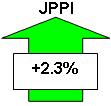 |
The table below summarizes price changes for precious metals as well as gemstones for the first six months of 2009. It is clear that precious metals prices are up sharply. If this rate of increase continues in the second half of the year, it implies that the price of platinum and silver could rise by more than 50 percent this year, though we believe that this is highly unlikely.
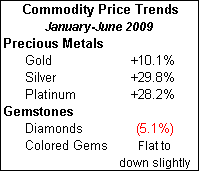
Source: IDEX Online, Kitco, GemGuide
How important are each of these commodities to jewelers? The numbers vary, but diamonds represent about 45 percent of a typical American jeweler’s sales. Gold jewelry represents about 7 percent of jewelry sales, according to the Jewelers of America Cost of Doing Business Survey. However, the World Gold Council reports gold jewelry sales differently – including the total retail value of the piece where gold is more than half of the underlying cost of the piece – and their numbers suggest that up to 27 percent of a jeweler’s sales are derived from jewelry with gold in it. Either way, gold is an important metal for jewelry and jewelers. Platinum jewelry represents less than 2 percent of a jeweler’s sales. Colored gemstone jewelry is about 9 percent of a jeweler’s annual revenues. There is no reliable estimate for silver jewelry, but it is very small – perhaps no more than 2 percent of total fine jewelry industry revenues.
What is pushing up the price of precious metals? Traditionally, gold – and some other precious metals – have been a safe harbor in a recessionary environment. As global stock markets have pulled back, investors have sought gold as a refuge during the storm. GFMS, the gold consultants, suggest that virtually the entire increase in gold prices recently has been fueled by purchasers of “investment gold.” Further, people buy gold as a hedge against inflation. Finally, people convert their local currencies into gold, especially when they think a major devaluation of their currency is imminent. To a lesser degree, other precious metals such as silver and platinum have reacted similarly. Platinum and silver are also used in manufacturing operations related to many industries. Since the global recession appears to be abating, both manufacturers and speculators have begun pushing up the prices of those metals.
Gemstone prices are another matter. Because the diamond markets are closed to outsiders – speculators, uninformed investors, hoarders and others with little knowledge of the industry and how it works – prices have not been nearly as volatile as they have been in the commodities markets. While diamond prices are down about 5 percent since the beginning of the year, they have held up reasonably well over the past two years, especially in the face of global turmoil in the financial markets.
From peak to valley, polished diamond prices fell only 15 percent, and appear to have bottomed. There’s no stock market in the world – nor is there any major commodity – that has shown such a small amount of volatility over the past two years. Recent reports suggest that some rough diamond prices have surged by 25 percent. If so, it will be only a matter of time before polished prices begin to climb, putting more pressure on suppliers to raise their prices. In turn, the JPPI (Jewelry Producer Price Index) will also push higher. Colored gemstone prices have remained more or less flattish to down slightly, according to GemGuide, the publishers of colored gemstone prices for the U.S. jewelry industry.
The June JPPI was below the average of the Jewelry Producer Price Index for 2008, which averaged +6.3 percent for the full year. However, the 2.3 percent gain in June is well above the annual inflation rate – which averaged about 0.7 percent – that characterized the jewelry producer industry in 2000 through 2002, also a recessionary period. June’s inflation rate is also above the long term Jewelry Producer Price Index increase of about 1.4-1.5 percent annually.
The following graph summarizes the monthly Jewelry Producer Price Index for inflation since mid-2007. The percentage figures are based on year-to-year comparisons of the BLS Jewelry Producer Price Index (June 2009 versus June 2008).
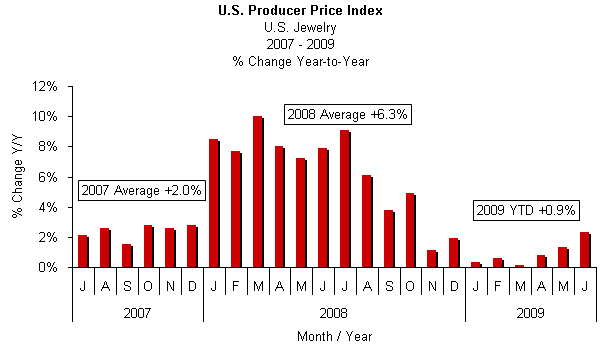
Source: BLS
After showing only very modest increases earlier this year, prices for both precious metal jewelry and gemstone jewelry have begun to rise in recent months. The graph below compares the JPPI (red bars) to inflation for precious metals (gold bars); gold had been the primary driver of precious metals inflation in 2007 and most of 2008. In January 2009, gold prices pulled back modestly, but have risen recently. In our opinion, $1,000 gold has been priced into goods produced by jewelry manufacturers. If gold goes higher, as some analysts suggest, that will put further pressure on jewelry suppliers to raise prices.
As the graph below illustrates, prices for precious metals used in jewelry at the supplier (producer) level are showing notable inflation.
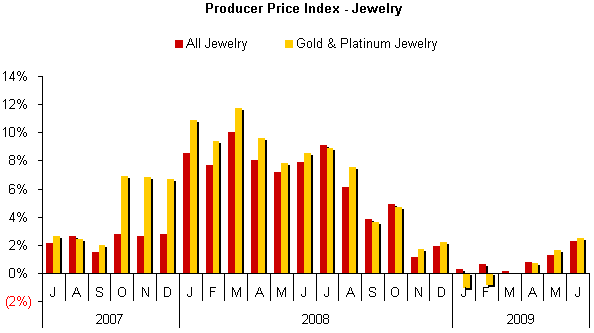
Source: BLS
Jewelry Consumer Price Index (JCPI) +0.9 percent in June
U.S. jewelry consumer prices (JCPI) rose by 0.9 percent in June 2009, as calculated by the BLS. After rising sharply through the second quarter of 2008, jewelry price increases at the retail level moderated in the late summer of last year, a continuing trend due primarily to the current recessionary environment. June’s inflation rate was the smallest this year. 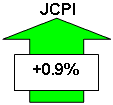
For the full year 2008, retail price inflation for jewelry in the U.S. market ran at an annual rate of +6.9 percent. Now, however, it is clear that jewelry price inflation is moderating, and it will likely remain lower than 2008 in the coming months, especially as we reach the anniversary of last year’s price increases that jewelers implemented in the second quarter of 2008.
The jewelry price inflation rate at the retail level in June fell notably below the average of the past two decades: about +1.6 percent.
The graph below summarizes the percentage change in retail prices of jewelry and watches by month on a year-to-year basis since the beginning of 2008. The percentage change is based on a comparison to the same month a year ago (June 2009 versus June 2008).
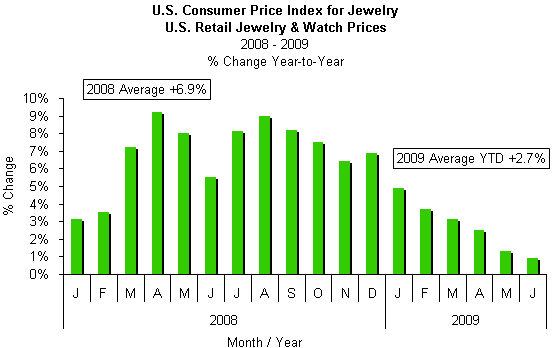
Source: BLS
Watch Price Inflation Slows
After bouncing around for several months, it has become clear that watch price inflation at the retail level is moderating. Early in 2008, the components of jewelry and watch price inflation at the retail level reflected a disparity in price increases. Jewelry retail prices were up consistently during the first half of 2008, but watch retail prices showed virtually no price inflation. Earlier this year, watch price inflation steadily increased. In April, watch price inflation slowed dramatically. In May, retail prices of watches inched higher than in April, but the inflation rate was still below earlier months in 2009. In June, watch price inflation diminished significantly. While there were several factors which contributed to inflationary pricing trends of watches – a shortage of mechanical watch movements in Switzerland and strong demand at the very high end – these factors have largely dissipated due to weak demand at most all levels and price points of the watch distribution chain. We expect watch price inflation to track more closely to retail jewelry price inflation over the near term.
The graph below illustrates the JCPI consisting of both jewelry and watch prices (green bars), jewelry prices only (red bars), and watch prices (yellow bars).
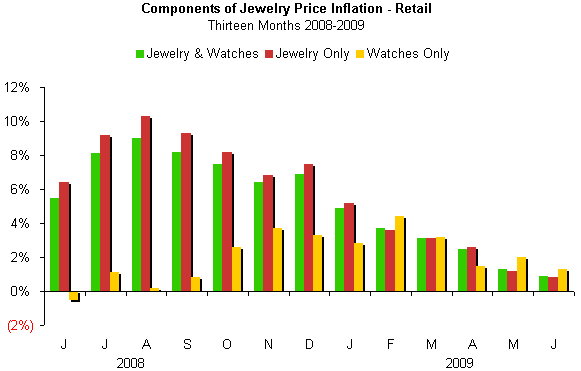
Source: BLS
Outlook: Modest Jewelry Price Inflation in 2009
After rising by nearly 7 percent in 2008, we continue to forecast much more modest jewelry and watch price inflation during 2009. The wild card, of course, is the price of commodities, including gold, silver, and platinum. If investors continue to buy these commodities as hedges against inflation – as historical economic recovery models suggest – it will put upward cost pressure on jewelry suppliers, who will try to pass those price increases along to retailers.
Our current prediction calls for 2009 jewelry price inflation to be in the low single digit level. The U.S. economy – which accounts for roughly half of all jewelry demand worldwide (by value) – is showing signs that the recession has bottomed (recently, one economist even went so far as to declare that the recession had ended in June!). Thus, if consumer demand recovers, we won’t experience price deflation; instead, we could experience modest price inflation. Inflation, coupled with improved demand for jewelry, could yield a year in which total jewelry sales will be flattish to slightly higher than in 2008. That’s what our latest revised jewelry sales forecast suggests, and it is a pleasant thought!